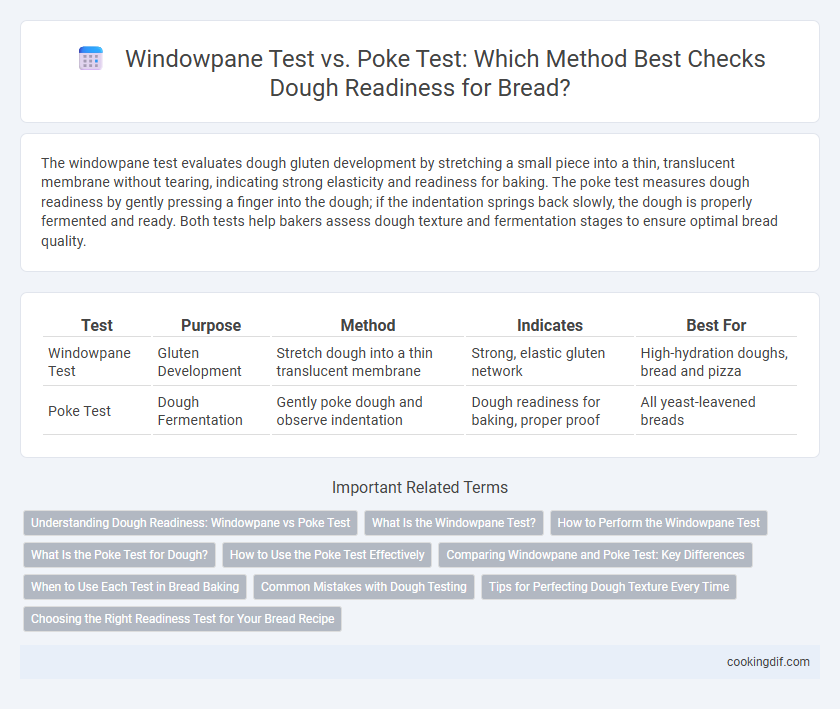The windowpane test evaluates dough gluten development by stretching a small piece into a thin, translucent membrane without tearing, indicating strong elasticity and readiness for baking. The poke test measures dough readiness by gently pressing a finger into the dough; if the indentation springs back slowly, the dough is properly fermented and ready. Both tests help bakers assess dough texture and fermentation stages to ensure optimal bread quality.
Table of Comparison
| Test | Purpose | Method | Indicates | Best For |
|---|---|---|---|---|
| Windowpane Test | Gluten Development | Stretch dough into a thin translucent membrane | Strong, elastic gluten network | High-hydration doughs, bread and pizza |
| Poke Test | Dough Fermentation | Gently poke dough and observe indentation | Dough readiness for baking, proper proof | All yeast-leavened breads |
Understanding Dough Readiness: Windowpane vs Poke Test
The windowpane test assesses dough readiness by stretching a small piece of dough until it forms a thin, translucent membrane without tearing, indicating sufficient gluten development. The poke test measures readiness by gently pressing the dough with a finger, where a slow, gradual bounce-back suggests proper fermentation and elasticity. Both tests provide critical insights into gluten strength and fermentation progress, helping bakers determine optimal dough handling and baking timing.
What Is the Windowpane Test?
The windowpane test is a method used to determine dough readiness by stretching a small piece of dough into a thin, translucent membrane without tearing, indicating proper gluten development. This test ensures the dough has elasticity and strength necessary for optimal bread texture. Unlike the poke test, which assesses dough spring back, the windowpane test provides a more precise evaluation of gluten structure.
How to Perform the Windowpane Test
To perform the windowpane test, gently stretch a small piece of dough between your fingers until it forms a thin, translucent membrane without tearing. This method assesses gluten development and dough elasticity, indicating proper kneading and readiness for fermentation. If the dough tears easily, additional kneading is necessary to strengthen the gluten network before proceeding.
What Is the Poke Test for Dough?
The poke test for dough assesses its readiness by gently pressing a finger into the surface and observing the dough's response. If the indentation slowly springs back, it indicates the dough has developed enough gluten and is properly proofed for baking. This simple method offers a quick, tactile way to gauge dough elasticity and fermentation progress without specialized tools.
How to Use the Poke Test Effectively
To use the poke test effectively, press a finger gently into the dough's surface and observe the indentation's behavior: if it springs back slowly and leaves a slight impression, the dough is adequately proofed and ready. A quick rebound indicates under-proofing, while no bounce back suggests over-proofing. Consistent practice of this simple tactile method helps bakers gauge dough elasticity and fermentation progress without the need for specialized tools.
Comparing Windowpane and Poke Test: Key Differences
The windowpane test evaluates gluten development by stretching dough thin to check for elasticity and strength, indicating optimal readiness for baking. The poke test measures dough's resilience by gently pressing and observing how quickly it springs back, reflecting fermentation progress and gas retention. While the windowpane test focuses on gluten structure, the poke test assesses dough fermentation, making both essential for determining proper dough readiness in baking.
When to Use Each Test in Bread Baking
The windowpane test is ideal for assessing gluten development in well-hydrated doughs, particularly enriched or high-protein bread recipes, where a thin, translucent membrane indicates proper gluten formation. The poke test suits starter-based or less hydrated doughs, providing a quick check for fermentation progress by observing if the dough springs back slowly, signaling readiness for shaping or proofing. Choosing the correct test depends on dough hydration and type, with the windowpane test offering precision for extensibility, while the poke test efficiently gauges fermentation status.
Common Mistakes with Dough Testing
Common mistakes in dough testing include misinterpreting the windowpane and poke tests, leading to under- or over-proofed bread. Relying solely on the poke test can cause bakers to overlook gluten development, while an improper windowpane test might indicate readiness incorrectly due to uneven dough hydration. Accurate dough assessment requires combining both tests and understanding their specific indicators to ensure optimal bread texture and rise.
Tips for Perfecting Dough Texture Every Time
Achieving the perfect dough texture relies on mastering the windowpane test, which reveals gluten development by stretching dough into a thin, translucent membrane without tearing. The poke test complements this by assessing dough elasticity and resilience, where a gentle indent should gradually bounce back, indicating optimal fermentation. Combining these techniques ensures consistent dough readiness, yielding airy, well-structured bread every bake.
Choosing the Right Readiness Test for Your Bread Recipe
The windowpane test is ideal for high-hydration doughs or recipes requiring strong gluten development, as it assesses dough elasticity and strength by stretching a thin, translucent membrane without tearing. The poke test suits wetter or stickier doughs, measuring readiness based on how quickly the dough springs back after being gently pressed, indicating proper fermentation and gas retention. Selecting the appropriate test depends on dough texture and recipe requirements to ensure optimal rise and crumb structure in your bread.
Windowpane test vs Poke test for dough readiness Infographic

 cookingdif.com
cookingdif.com